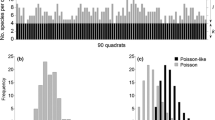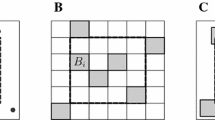Abstract
The traditional sampling method for estimating frequency (the number of sub-quadrats containing a basal part of the organisms) is compared, using both computer simulations and direct comparison in the field, to two new methods that use a compound series of variable-sized concentric sub-quadrats. Both the new frequency-score and the new importance-score methods are closer approximations of density than is the standard frequency method, and the estimates produced by both of the new methods are less affected by the choice of sub-quadrat size and the spatial distribution (dispersion) of the organisms (i.e. clumping and regularity). Thus, the two nested-quadrat methods appear to ameliorate the usual frequency limitations associated with sub-quadrat size and organism dispersion, by the use of a range of different sub-quadrat sizes. This is important in community studies, where the component species may show a wide range of densities and dispersions. Both of the new methods are easily employed in the field. The importance-score method involves no more sampling effort than does standard qualitative (presence-absence) sampling, and it can therefore be used to sample a larger quadrat area than would normally be used for frequency sampling. This makes the method much more cost-effective as a means of estimating abundance, and it allows a greater number of the rarer species to be included in the sampling. The frequency-score method is more time-consuming, but it is capable of detecting more subtle community patterns. This means that it is particularly useful for the study of species-poor communities or where small variations in composition need to be detected.
Similar content being viewed by others
References
Bonham, C.D. (1989). Measurements for terrestrial vegetation. Wiley, New York.
Buckney, R.T. & Morrison, D.A. (1992). Temporal trends in plant species composition on mined sand dunes in Myall Lakes National Park, Australia. Australian Journal of Ecology 17: 241–254.
Bunce, R.G.H. & Shaw, M.W. (1973). A standardized procedure for ecological survey. Journal of Environmental Management 1: 239–258.
Causton, D.R. (1988). An introduction to vegetation analysis. Unwin Hyman, London.
Clarke, P.J. & Benson, D. (1986). Vegetation survey of Dharug National Park. Royal Botanic Gardens, Sydney.
Faith, D.P. Minchin, P.R. & Belbin, L. (1987). Compositional dissimilarity as a robust measure of ecological distances: A theoretical model and computer simulations. Vegetatio 69: 57–68.
Goldsmith, F.B. Harrison, C.M. & Morton, A.J. (1986). Description and analysis of vegetation. in Moore, P.D. & Chapman, S.B. (eds), Methods in plant ecology, 2nd ed. Blackwell, Oxford, pp. 437–524.
Greig-Smith, P. (1983). Quantitative plant ecology, 3rd ed. Blackwell, Oxford.
Hill, H.O. (1979). TWINSPAN: A Fortran program for arranging multivariate data in an ordered two-way table by classification of the individuals and attributes. Cornell University, Ithaca NY.
Hill, M.O. Bunce, R.G.H. & Shaw, M.W. (1975). Indicator species analysis, a divisive polythetic method of classification, and its application to a survey of native pinewoods in Scotland. Journal of Ecology 63: 597–613.
Hyder, D.N. Bement, R.E. Remmenger, E.E. & Terwilliger, C. (1965). Frequency sampling of blue grama range. Journal of Rangeland Management 18: 90–94.
Kershaw, K.A. & Looney, J.H.H. (1985). Quantitative and dynamic plant ecology, 2nd ed. Edward Arnold, London.
Le, Brocque, A.F. & Buckney, R.T. (1995). Vegetation and environmental patterns on soils derived from Hawkesbury Sandstone and Narrabeen sub-strata in Ku-ring-gai Chase National Park, NSW. Australian Journal of Ecology 20: 229–238.
Morrison, D.A. Cary, G.J. Pengelly, S.M. Ross, D.G. Mullins, B.J. Thomas, C.R. & Anderson, T.S. (1995). Effects of fire frequency on plant species composition of sandstone communities in the Sydney region: Inter-fire interval and time-since-fire. Australian Journal of Ecology 20: 239–247.
Ludwig, J.A. & Reynolds, J.F. (1988). Statistical ecology: A primer on methods and computing. Wiley, New York.
Mueller-Dombois, D. & Ellenberg, H. (1974). Aims and methods of vegetation ecology. Wiley, New York.
Outhred, R.K. (1984). Semi-quantitative sampling in vegetation survey. in Myers, K. Margules, C.R. & Musto, I. (eds), Survey methods for nature conservation. CSIRO, Canberra, pp. 87–100.
Outhred, R.K. & Buckney, R.T. (1983). The vegetation of Kooragang Island, New South Wales. Wetlands (Australia) 3: 58–70.
Outhred, R. Lainson, R. Lamb, R. & Outhred, D. (1985). A floristic survey of Ku-ring-gai Chase National Park. Cunninghamia 1: 313–338.
Penridge, L.K. (1986). LPOINT: A computer program to simulate a continuum of two-dimensional point patterns from regular, through Poisson, to clumped. CSIRO, Canberra.
Smartt, P.F.M. Meacock, S.E. & Lambert, J.M. (1974). Investigations into the properties of quantitative vegetational data I. Pilot study. Journal of Ecology 62: 735–759.
Smartt, P.F.M. Meacock, S.E. & Lambert, J.M. (1976). Investigations into the properties of quantitative vegetational data II. Further data type comparisons. Journal of Ecology 64: 41–78.
Wilkinson, L. (1986). SYSTAT: The system for statistics. Systat Inc., Evanston IL.
Wu, H. Malafant, K.W.J. Penridge, L.K. Sharp, P.J.H. & Walker, J. (1987). Simulation of two-dimensional point patterns: application of a lattice framework approach. Ecological Modelling 38: 299–308.
Author information
Authors and Affiliations
Rights and permissions
About this article
Cite this article
Morrison, D.A., Le Brocque, A.F. & Clarke, P.J. An assessment of some improved techniques for estimating the abundance (frequency) of sedentary organisms. Vegetatio 120, 131–145 (1995). https://doi.org/10.1007/BF00034343
Accepted:
Issue Date:
DOI: https://doi.org/10.1007/BF00034343




